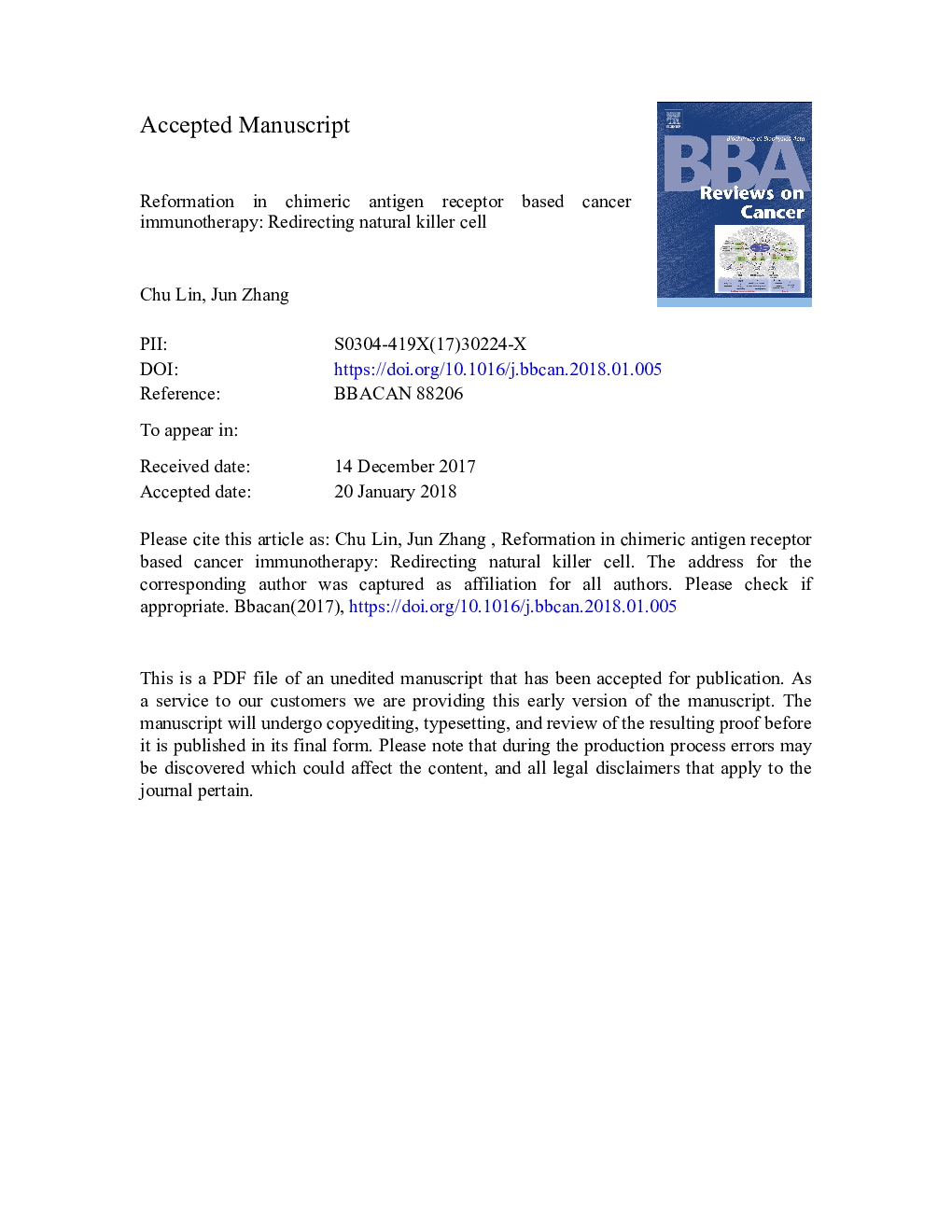| Article ID | Journal | Published Year | Pages | File Type |
|---|---|---|---|---|
| 8429335 | Biochimica et Biophysica Acta (BBA) - Reviews on Cancer | 2018 | 69 Pages |
Abstract
Natural killer (NK) cells are an important subset of lymphocytes which play a critical role in host immunity against cancers. With MHC-independent recognition, short lifespan and potent cytotoxicity, NK cells make a promising candidate for chimeric antigen receptor (CAR)-engineered cancer immunotherapy. Due to innate biological properties of NK cells, CAR-NK may outperform CAR-T therapy in terms of less side effects and more universal access, which may become a great reformation in CAR-based cancer immunotherapy. The CARs used in peripheral blood (PB) NK cells as well as NK cell line like NK-92 are the most important outfits defining antigenic specificity. The constructs of CARs used in NK cells from different sources vary, which all undergo generational optimization. The anti-tumor effects of CAR-NK have been validated in numerous preclinical trials for cancers, including hematologic malignancies and many solid tumors, which provide evidence for potential clinical application of CAR-NK. Additionally, this review concludes the challenges faced in the application of CAR-NK. Although CAR-NK is considered as one of the most possible “off-the-shelf” products, the improvement for the efficiency of expansion and transduction as well as the solution for underlying safety issues is still needed. Possible coping strategies for challenges and upgrades in techniques are also highlighted for future development in CAR-NK cancer immunotherapy.
Keywords
EGFRADCCTAACRISPRPBMCSCCscFvDAPTCrCRSSHPACTGMPIFN-γHDACiIPSCEGFRvIIIKirNCRGM-CSFITIMCCLL1CAMNHLHSCTEpCAMUCBCLLNKG2ANKG2DITAMHSPCITSMMRDC-C motif ligandCytokine-induced killer cellZFN4-1BBLL1 cell adhesion moleculeEAT-2PSCAKiller cell Ig-like receptorGvHD4-1BB ligandAMLHCCantibody dependent cell-mediated cytotoxicityHuman leukocyte antigentumor-associated antigenHLAEBVimmunotherapyinterferon-γinterleukinclustered regularly interspaced short palindromic repeatsTERTTelomerase reverse transcriptasetumor necrosis factor-αMinimal residual diseaseESCUmbilical cord bloodPeripheral bloodadoptive cell therapyGood Manufacturing PracticesTALENBBBCancerNK cellHematopoietic stem/progenitor cellPeripheral blood mononuclear cellDendritic cellNatural killer cellEmbryonic stem cellInduced pluripotent stem cellCytokine Release Syndromegranulocyte-macrophage colony-stimulating factorTNF-αTRAILsingle-chain variable fragmentnon-Hodgkin's lymphomaHodgkin's lymphomaacute myeloid leukemiaacute lymphocytic leukemiaChronic lymphocytic leukemiaImmunoreceptor tyrosine-based switch motifCARBlood-brain barrierMHCmajor histocompatibility complexhistone deacetylase inhibitorMultiple myelomaimmunoreceptor tyrosine-based activation motifImmunoreceptor tyrosine-based inhibitory motifALLEpstein-Barr virusGraft versus host diseaseHematopoietic stem cell transplantationSquamous cell carcinomaHepatocellular carcinomaTruckGlioblastomachimeric antigen receptorT cell receptornatural cytotoxicity receptorEpidermal growth factor receptor
Related Topics
Life Sciences
Biochemistry, Genetics and Molecular Biology
Cancer Research
Authors
Chu Lin, Jun Zhang,
